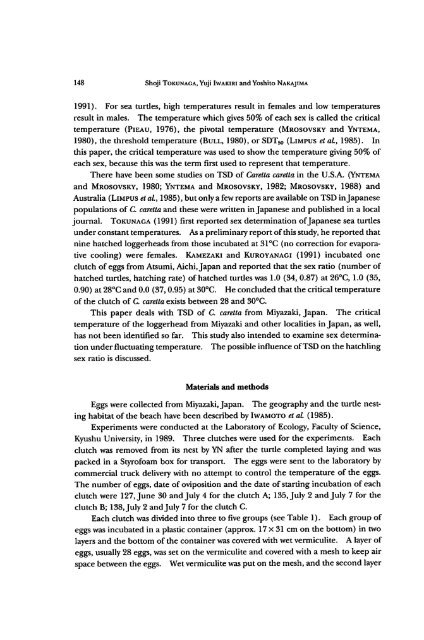Temperature-dependent Sex Determination of a Sea Turde, Caretta ...
Temperature-dependent Sex Determination of a Sea Turde, Caretta ...
Temperature-dependent Sex Determination of a Sea Turde, Caretta ...
You also want an ePaper? Increase the reach of your titles
YUMPU automatically turns print PDFs into web optimized ePapers that Google loves.
148 Shoji Tokunaga, Yuji Iwakiri and Yoshito Nakajima<br />
1991). For sea turdes, high temperatures result in females and low temperatures<br />
result in males. The temperature which gives 50% <strong>of</strong> each sex is called the critical<br />
temperature (Pieau, 1976), the pivotal temperature (Mrosovsky and Yntema,<br />
1980), the threshold temperature (Bull, 1980), or SDT50 (Limpus et al, 1985). In<br />
this paper, the critical temperature was used to show the temperature giving 50% <strong>of</strong><br />
each sex, because this was the term first used to represent that temperature.<br />
There have been some studies on TSD <strong>of</strong> <strong>Caretta</strong> caretta in the U.S.A. (Yntema<br />
and Mrosovsky, 1980; Yntema and Mrosovsky, 1982; Mrosovsky, 1988) and<br />
Australia (Limpus etal, 1985), but only a few reports are available on TSD inJapanese<br />
populations <strong>of</strong> C. caretta and these were written in Japanese and published in a local<br />
journal. Tokunaga (1991) first reported sex determination <strong>of</strong>Japanese sea turtles<br />
under constant temperatures. Asa preliminary report <strong>of</strong>this study, he reported that<br />
nine hatched loggerheads from those incubated at 31°C (no correction for evapora<br />
tive cooling) were females. Kamezaki and Kuroyanagi (1991) incubated one<br />
clutch <strong>of</strong>eggs from Atsumi, Aichi,Japan and reported that the sex ratio (number <strong>of</strong><br />
hatched turtles, hatching rate) <strong>of</strong> hatched turdes was 1.0 (34, 0.87) at 26°C, 1.0 (35,<br />
0.90) at 28°C and 0.0 (37,0.95) at 30°C. He concluded that the critical temperature<br />
<strong>of</strong> the clutch <strong>of</strong> C. caretta exists between 28 and 30°C.<br />
This paper deals with TSD <strong>of</strong> C. caretta from Miyazaki, Japan. The critical<br />
temperature <strong>of</strong> the loggerhead from Miyazaki and other localities in Japan, as well,<br />
has not been identified so far. This study also intended to examine sex determina<br />
tion underfluctuating temperature. The possible influence <strong>of</strong>TSD on the hatchling<br />
sex ratio is discussed.<br />
Materials and methods<br />
Eggs were collected from Miyazaki,Japan. The geography and the turtle nest<br />
ing habitat <strong>of</strong> the beach have been described by Iwamoto etal (1985).<br />
Experiments were conducted at the Laboratory <strong>of</strong> Ecology, Faculty <strong>of</strong> Science,<br />
Kyushu University, in 1989. Three clutches were used for the experiments. Each<br />
clutch was removed from its nest by YN after the turtle completed laying and was<br />
packed in a Styr<strong>of</strong>oam box for transport. The eggs were sent to the laboratory by<br />
commercial truck delivery with no attempt to control the temperature <strong>of</strong> the eggs.<br />
The number <strong>of</strong> eggs, date <strong>of</strong> oviposition and the date <strong>of</strong> starting incubation <strong>of</strong>each<br />
clutch were 127,June 30 and July 4 for the clutch A; 135,July 2 and July 7 for the<br />
clutch B; 138,July 2 andJuly 7 for the clutch C.<br />
Each clutch was divided into three to five groups (see Table 1). Each group <strong>of</strong><br />
eggswasincubated in a plasticcontainer (approx. 17 x 31 cm on the bottom) in two<br />
layers and the bottom <strong>of</strong> the container was coveredwithwet vermiculite. A layer<strong>of</strong><br />
eggs, usually 28 eggs, was set on the vermiculite and covered with a mesh to keep air<br />
spacebetween the eggs. Wetvermiculite was put on the mesh,and the secondlayer
















